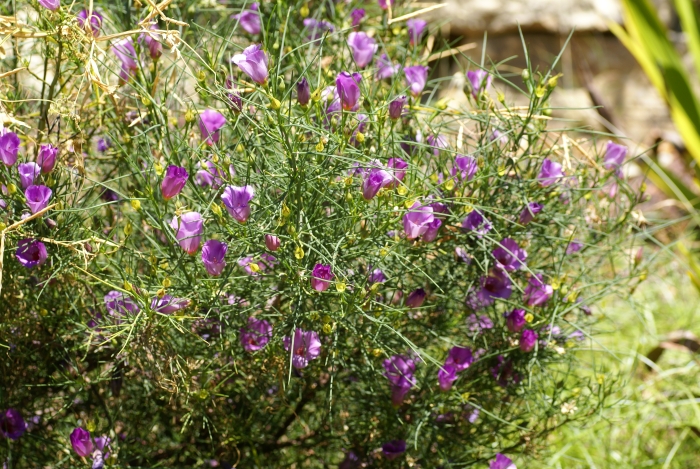Australian Hibiscus
(Hibiscus hakeifolius)
Australian Hibiscus (Hibiscus hakeifolius)
/
/

Rolf Engstrand
CC BY-SA 4.0
Image By:
Rolf Engstrand
Recorded By:
Copyright:
CC BY-SA 4.0
Copyright Notice:
Photo by: Rolf Engstrand | License Type: CC BY-SA 4.0 | License URL: https://creativecommons.org/licenses/by-sa/3.0 | Uploader: Rolf Engstrand | Publisher: Wikimedia Commons |
























Estimated Native Range
Summary
Hibiscus hakeifolius, commonly referred to as Australian Hibiscus, is an evergreen shrub native to the sandy plains and open woodlands of Southern Australia. This species, once thought to be a true Hibiscus, is now classified in its own genus, Alyogyne. It has been a feature in English gardens since the mid-nineteenth century. Alyogyne hakeifolia typically grows up to three meters high and is characterized by its dense coverage of fine, needle-like leaves. The plant is notable for its rapid growth under optimal conditions.
Australian Hibiscus is admired for its large, showy flowers that bloom from late autumn to early spring (May to February in its native habitat). The flowers come in hues of blue, purple, or creamy yellow and are deeply cupped, becoming papery as they age. The shrub is valued for its ability to produce abundant blooms after the first or second year of growth. In cultivation, it is often used as a feature plant in gardens and landscapes due to its attractive foliage and flowers. It requires well-drained soil, protection from frost, and careful fertilization to avoid phosphorus toxicity. Australian Hibiscus thrives in full sun and is drought-tolerant once established, making it suitable for xeriscaping. Propagation is commonly achieved through cuttings. While it is not known for significant pest or disease issues, it may be susceptible to root rot in poorly drained soils.CC BY-SA 4.0
Australian Hibiscus is admired for its large, showy flowers that bloom from late autumn to early spring (May to February in its native habitat). The flowers come in hues of blue, purple, or creamy yellow and are deeply cupped, becoming papery as they age. The shrub is valued for its ability to produce abundant blooms after the first or second year of growth. In cultivation, it is often used as a feature plant in gardens and landscapes due to its attractive foliage and flowers. It requires well-drained soil, protection from frost, and careful fertilization to avoid phosphorus toxicity. Australian Hibiscus thrives in full sun and is drought-tolerant once established, making it suitable for xeriscaping. Propagation is commonly achieved through cuttings. While it is not known for significant pest or disease issues, it may be susceptible to root rot in poorly drained soils.CC BY-SA 4.0
Plant Description
- Plant Type: Shrub
- Height: 6-9 feet
- Width: 4.5-6 feet
- Growth Rate: Moderate
- Flower Color: Purple
- Flowering Season: Spring, Summer
- Leaf Retention: Evergreen
Growth Requirements
- Sun: Full Sun
- Water: Low
- Drainage: Fast
Common Uses
Bee Garden, Bird Garden, Border Plant, Butterfly Garden, Hummingbird Garden, Low Maintenance, Salt Tolerant, Showy Flowers
Natural Habitat
Sandy plains and open woodlands of Southern Australia
Other Names
Common Names: Alyogyne Hakeifolia
Scientific Names: , Alyogyne hakeifolia, Hibiscus hakeifolius, Cienfuegosia hakeifolia, Fugosia hakeifolia, Hibiscus coronopifolius, Alyogyne lilacina, Alyogyne multifida, Cienfuegosia hakeifolia var. genuina, Cienfuegosia hakeifolia var. lilacina
GBIF Accepted Name: Hibiscus hakeifolius Giord.